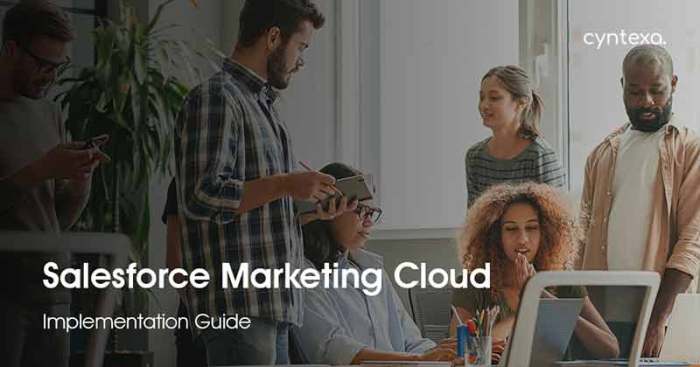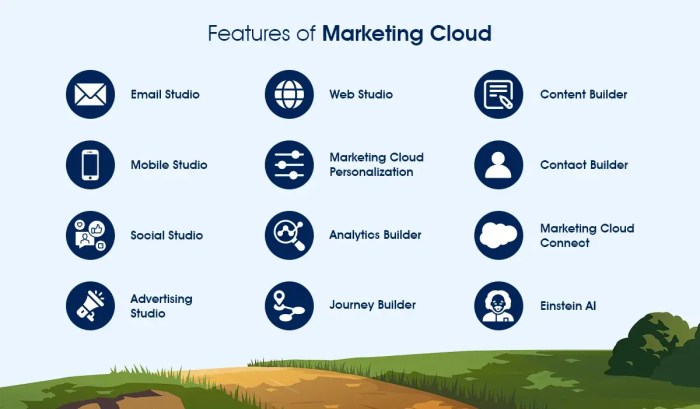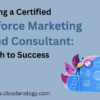Salesforce Marketing Cloud features guide provides a deep dive into the powerful capabilities of this marketing platform. This guide explores the core functionalities, from email marketing to social media campaigns, and delves into practical applications, technical aspects, and best practices for optimizing your marketing efforts. We’ll cover everything from the basics of the platform to advanced features like journey builder and segmentation, all while examining integration with other tools and troubleshooting common issues.
The guide is designed to equip marketers with the knowledge to effectively leverage Salesforce Marketing Cloud. It breaks down the complexities of the platform into digestible chunks, making it easier to understand and implement the features for your business. We’ll discuss how to maximize ROI, customer engagement, and overall marketing performance. From a simple email campaign to a sophisticated customer journey, this guide is your essential resource.
Introduction to Salesforce Marketing Cloud
Salesforce Marketing Cloud is a powerful platform designed to help businesses connect with their customers in meaningful ways. It’s a suite of integrated marketing automation tools that streamline various marketing activities, from email campaigns to social media management. This platform is not just about sending emails; it’s about understanding customer behavior, personalizing interactions, and ultimately, driving business growth.This platform empowers businesses of all sizes to build robust customer journeys, fostering stronger relationships and increasing conversion rates.
It leverages data-driven insights to tailor marketing efforts, ensuring that messages resonate with individual customer needs and preferences.
Core Functionalities of Salesforce Marketing Cloud
Salesforce Marketing Cloud provides a comprehensive range of tools for managing and executing various marketing campaigns. These tools work seamlessly together, providing a unified platform for all marketing activities. Key functionalities include email marketing, social media marketing, mobile marketing, and advertising management. The platform’s robust analytics capabilities allow businesses to track campaign performance and make data-driven decisions.
Key Benefits of Using Salesforce Marketing Cloud
The platform’s benefits extend beyond simply managing campaigns. Businesses gain a significant advantage through improved customer engagement, enhanced personalization, and increased marketing ROI. The integrated approach streamlines marketing processes, reducing manual effort and improving overall efficiency. Furthermore, the platform’s robust analytics capabilities enable businesses to measure the impact of campaigns, optimize strategies, and identify areas for improvement.
Improved customer segmentation and targeted marketing campaigns directly result in increased conversion rates and revenue generation.
Types of Marketing Automation Tools in Salesforce Marketing Cloud
Salesforce Marketing Cloud offers a diverse range of tools to automate various marketing processes. These tools are designed to help businesses streamline their marketing efforts and improve efficiency. Key examples include email marketing automation, social media management, and mobile marketing solutions. A robust set of tools to create personalized experiences based on customer data is available, allowing for tailored interactions and optimized engagement.
Salesforce Marketing Cloud Tiers/Editions
Different tiers of Salesforce Marketing Cloud cater to various business needs and budgets. Each tier offers a unique combination of features and functionalities, allowing businesses to select the best fit for their requirements.
| Tier/Edition | Key Features | Suitable for |
|---|---|---|
| Essential | Basic email marketing, automation, and reporting. | Small businesses and startups with limited marketing budgets. |
| Professional | Advanced features like segmentation, personalization, and social media management, along with more robust reporting. | Growing businesses looking to scale their marketing efforts and personalize customer experiences. |
| Enterprise | All features in Professional edition, plus advanced analytics, custom development options, and dedicated support. | Large enterprises requiring extensive customization and comprehensive marketing automation solutions. |
Core Features of Salesforce Marketing Cloud
Salesforce Marketing Cloud is a powerful platform for businesses to connect with their customers. Its core features enable comprehensive marketing strategies across various channels, allowing for personalized interactions and measurable results. This deep dive into the core features will cover email, SMS, and social media marketing, automation tools, segmentation, and targeting, showcasing how these components integrate seamlessly.The platform’s robust features go beyond simple campaign management.
It provides a holistic view of customer interactions, enabling businesses to nurture leads, convert prospects, and drive customer loyalty. This detailed exploration of core features empowers marketers to leverage the full potential of Salesforce Marketing Cloud for impactful campaigns.
I’ve been diving deep into the Salesforce Marketing Cloud features guide lately, and it’s fascinating how much it covers. But, to really optimize your campaigns, understanding how to achieve ad precision with Google’s new brand controls, like those detailed in achieving ad precision with googles new brand controls , is crucial. Ultimately, mastering both will give you a powerful edge in the digital marketing landscape, making the Salesforce Marketing Cloud features guide even more impactful.
Email Marketing Features
Email marketing remains a cornerstone of digital marketing. Salesforce Marketing Cloud’s email features go beyond simple broadcast emails. The platform enables dynamic content personalization, allowing for customized messages based on individual customer preferences and behaviors. A/B testing capabilities help optimize email campaigns for maximum open and click-through rates. Advanced features include automated email sequences, triggered emails based on specific customer actions, and real-time reporting on campaign performance.
SMS Marketing Capabilities
SMS marketing provides a direct and immediate channel for communication with customers. Salesforce Marketing Cloud’s SMS features facilitate personalized text message campaigns. Automated SMS workflows allow businesses to send timely updates, reminders, and confirmations. Businesses can also track campaign performance in real-time to measure engagement and optimize messaging.
Social Media Marketing Integration
Salesforce Marketing Cloud seamlessly integrates with various social media platforms. Businesses can manage and monitor social media activity, including scheduling posts, engaging with customers, and tracking campaign performance across different channels. The platform also enables targeted advertising and social listening to gather valuable insights into customer sentiment and trends.
Marketing Automation Tools
The platform’s automation tools are a crucial aspect of its capabilities. Salesforce Marketing Cloud provides a range of automation tools that streamline marketing workflows, freeing up marketing teams to focus on strategic initiatives. These tools automate tasks like lead nurturing, email sequences, and customer journey orchestration, maximizing campaign efficiency. Specific tools may vary based on the platform’s edition and chosen features.
Segmentation and Targeting Strategies
Effective segmentation and targeting are critical for maximizing campaign impact. Salesforce Marketing Cloud allows for sophisticated segmentation based on various customer attributes, behaviors, and interactions. This enables businesses to create highly targeted campaigns that resonate with specific customer segments. These features also allow for real-time adjustments to campaigns based on ongoing data analysis, leading to dynamic, responsive campaigns.
Integration of Features
The various features of Salesforce Marketing Cloud seamlessly integrate, creating a unified platform for comprehensive marketing efforts. The following table demonstrates how different features work together to support a holistic marketing strategy.
| Feature | Integration with Email Marketing | Integration with SMS Marketing | Integration with Social Media |
|---|---|---|---|
| Segmentation | Targeted email lists based on customer profiles. | Targeted SMS messages based on segment criteria. | Targeted social media ads based on demographics and interests. |
| Automation | Automated email sequences triggered by customer actions. | Automated SMS workflows for order confirmations or reminders. | Automated social media posting schedules based on campaign goals. |
| Reporting | Real-time tracking of email campaign performance (opens, clicks). | Real-time tracking of SMS campaign performance (replies, delivery). | Real-time tracking of social media engagement and campaign reach. |
Practical Applications of Features
Salesforce Marketing Cloud isn’t just a collection of tools; it’s a powerful engine for driving marketing success. Understanding how to leverage its features in real-world scenarios is key to achieving tangible results. This section dives into practical applications, showcasing how specific features translate into measurable marketing outcomes.This exploration goes beyond the theoretical, focusing on tangible examples. We’ll delve into how email campaigns, lead nurturing, and customer journey management are implemented to achieve marketing objectives, along with practical strategies for creating effective workflows.
Furthermore, we’ll illustrate the construction and deployment of personalized customer journeys using specific features within the platform.
Email Campaign Examples
Email remains a cornerstone of digital marketing. Salesforce Marketing Cloud empowers marketers to create impactful email campaigns tailored to specific customer segments. A key aspect of this is segmentation. Imagine a company selling outdoor gear. By segmenting their customers based on past purchases, interests, and engagement levels, they can craft highly targeted email campaigns.
For instance, customers who bought hiking boots last year might receive emails promoting new trail maps and gear. This personalization significantly boosts open and click-through rates, ultimately driving conversions.
Lead Nurturing Strategies
Lead nurturing is a crucial process for converting prospects into paying customers. Salesforce Marketing Cloud excels in automating this process. A B2B software company, for example, might use the platform to send a series of emails to leads based on their interactions with the website. If a lead downloads a white paper, they could receive follow-up emails offering a free consultation or a demo.
The key is to provide valuable content and stay top-of-mind, ultimately leading to higher conversion rates.
Customer Journey Management
Customer journey management allows businesses to create a seamless experience across all touchpoints. A cosmetics company might use Marketing Cloud to personalize a customer’s journey from initial browsing to final purchase. For example, a customer who frequently views skincare products might receive targeted product recommendations and personalized offers via email and push notifications. This consistent, personalized experience builds brand loyalty and increases customer lifetime value.
Marketing Automation Workflows
Creating effective marketing automation workflows requires a strategic approach. Consider a clothing retailer that wants to encourage repeat purchases. They can set up an automated workflow that sends emails to customers after their first purchase, offering exclusive discounts on their next order. This encourages customer loyalty and drives repeat business. Further, these workflows can include abandoned cart emails, personalized product recommendations, and post-purchase surveys to improve customer satisfaction.
They can also include triggered emails based on specific customer behaviors, like a welcome email for new subscribers, or a reminder email for an upcoming event.
Building Personalized Customer Journeys
Personalized customer journeys are built on understanding individual customer needs and preferences. A financial institution, for instance, could use Marketing Cloud to tailor the customer journey based on a customer’s financial goals and risk tolerance. By analyzing past interactions and demographics, they can offer relevant financial products and services, ensuring the customer’s needs are met effectively. Furthermore, this personalized approach can significantly enhance customer engagement and loyalty.
So, you’re diving deep into Salesforce Marketing Cloud features? Knowing how to optimize your campaigns is key, but preparing for the holiday rush with Amazon FBA inventory limits is equally crucial. Check out this helpful guide on amazon fba inventory limits for holiday 4 steps to prepare now to get ahead of potential stockouts. Ultimately, a well-rounded approach to both marketing automation and inventory management is the best way to succeed this holiday season, and understanding the Salesforce Marketing Cloud features will help you with both.
Technical Aspects of Implementation
Diving into the nuts and bolts of Salesforce Marketing Cloud requires understanding its technical underpinnings. Successful implementation hinges on careful planning and consideration of the platform’s architecture, integration capabilities, and customization options. This section will explore the technical prerequisites, integration processes, and data management aspects crucial for a seamless transition.
Technical Requirements
Salesforce Marketing Cloud’s implementation necessitates a solid technological foundation. This includes adequate server resources, robust network infrastructure, and a stable internet connection. Furthermore, ensuring the appropriate bandwidth and processing power is critical for handling large volumes of data and executing complex marketing campaigns. This can include dedicated servers or cloud-based solutions. Specific requirements may vary based on the chosen features and scale of operations.
Integration with Other Platforms
Seamless integration with existing CRM and marketing platforms is paramount for a unified marketing strategy. Salesforce Marketing Cloud offers various APIs and connectors to facilitate data exchange with systems like Salesforce Sales Cloud, Eloqua, and Marketo. These integrations allow for real-time data synchronization, enabling a holistic view of customer interactions across all channels. The specific integration process depends on the target platform and desired functionality.
Data Sources for Integration, Salesforce marketing cloud features guide
The ability to integrate various data sources is a key strength of Salesforce Marketing Cloud. This enables a complete view of customer interactions.
| Data Source | Description | Example |
|---|---|---|
| Salesforce Sales Cloud | Customer relationship management data | Contact information, account details, purchase history |
| Marketing Automation Platforms | Marketing campaign data | Email open rates, click-through rates, landing page visits |
| CRM Systems (e.g., Microsoft Dynamics 365) | Customer information from other CRM platforms | Customer service interactions, support tickets |
| Website Analytics | Website traffic data | Page views, bounce rates, conversion rates |
| Social Media Platforms | Social media engagement data | Likes, shares, comments |
Configuration and Customization
Tailoring Salesforce Marketing Cloud to specific business needs involves configuration and customization. The platform’s user interface allows for adjusting workflows, creating custom fields, and configuring automated processes. Understanding the platform’s modular design allows for selective deployment of functionalities to align with particular marketing objectives. Specific customization steps may vary depending on the desired functionality.
Best Practices and Tips
Mastering Salesforce Marketing Cloud requires more than just understanding its features. It demands a strategic approach to campaign optimization, customer engagement, and performance tracking. This section dives into best practices, offering actionable insights to maximize your ROI and avoid common pitfalls.Effective use of Salesforce Marketing Cloud hinges on understanding the nuances of customer interaction and anticipating their needs.
By focusing on personalization, relevant messaging, and a seamless experience across channels, you can cultivate strong customer relationships and drive significant engagement. Understanding how to measure campaign success and adapt strategies based on performance data is crucial for sustained growth.
The Salesforce Marketing Cloud features guide is a great resource, but optimizing your social media strategy is key to unlocking its full potential. For instance, learning how to manage your organic social media to boost your paid performance here can significantly improve campaign ROI. Ultimately, mastering these combined strategies is crucial for effective marketing with the Salesforce Marketing Cloud.
Campaign Optimization and Performance Tracking
Campaign optimization is a continuous process of refinement, driven by data-driven insights. Regularly analyzing campaign performance metrics is essential to understanding what resonates with your audience and what needs adjustment.
- Segmentation Strategies: Tailoring messages to specific customer segments based on demographics, purchase history, or engagement levels is paramount for boosting campaign effectiveness. By creating detailed customer profiles, you can personalize interactions, leading to higher conversion rates and customer satisfaction. For example, sending a targeted email campaign to customers who haven’t purchased in the last quarter can encourage repeat business.
- A/B Testing: Employing A/B testing to compare different versions of emails, landing pages, or ad creatives is crucial for identifying the most effective variations. This iterative approach allows you to optimize campaigns based on real-time data and maximize engagement.
- Real-time Reporting and Analysis: Utilizing Marketing Cloud’s reporting features allows for a comprehensive view of campaign performance. Analyzing key metrics like open rates, click-through rates, conversion rates, and unsubscribe rates provides valuable insights for identifying areas of improvement and making data-driven decisions.
Improving Customer Engagement and Retention
Customer engagement is paramount to long-term success. By building relationships with customers, you cultivate loyalty and drive repeat business.
- Personalized Communication: Creating personalized experiences by incorporating customer data into messaging is crucial for building rapport and fostering a stronger connection. Tailoring email subject lines, product recommendations, and content to individual preferences demonstrates a genuine understanding of customer needs.
- Multi-Channel Engagement: Deploying campaigns across various channels, including email, SMS, social media, and mobile apps, provides a holistic approach to customer interaction. This integrated approach delivers consistent messaging and fosters stronger engagement, as customers can interact with your brand through multiple touchpoints.
- Customer Relationship Management (CRM) Integration: Integrating Salesforce Marketing Cloud with your CRM system provides a unified view of customer data. This unified view allows for a more holistic approach to customer interaction, providing valuable insights for personalized campaigns.
Measuring Campaign Success and ROI
Quantifying the impact of your campaigns is crucial for justifying investments and optimizing future efforts. Understanding your return on investment (ROI) is paramount.
- Defining Key Performance Indicators (KPIs): Clearly defining KPIs, such as conversion rates, revenue generated, or customer lifetime value, provides a structured framework for evaluating campaign performance. Establishing measurable goals ensures that your efforts align with business objectives and provide concrete metrics for success.
- Attribution Modeling: Implementing attribution modeling to track the contribution of different touchpoints in a customer’s journey is critical for understanding the effectiveness of various channels. Accurate attribution allows you to optimize your marketing spend and maximize your return on investment.
- Cost-Benefit Analysis: Conducting a comprehensive cost-benefit analysis of campaigns allows for a clear understanding of the financial implications and return on investment. This analysis allows for informed decisions about campaign optimization and budget allocation.
Potential Pitfalls to Avoid
Careful planning and execution are critical for successful Salesforce Marketing Cloud implementation. Addressing potential pitfalls is crucial for achieving desired results.
- Data Quality Issues: Maintaining accurate and up-to-date customer data is essential for delivering personalized experiences and effective campaigns. Data inaccuracies can lead to misdirected messaging and ineffective campaigns. Regular data cleansing and validation are vital to ensure campaign success.
- Lack of Testing and Optimization: Thorough testing and optimization of campaigns are crucial for ensuring campaign effectiveness. Insufficient testing can result in suboptimal performance and wasted resources. Comprehensive testing across different channels and customer segments is essential.
- Ignoring Customer Preferences: Ignoring customer preferences and sending irrelevant or unwanted messages can negatively impact brand perception and customer relationships. Prioritizing customer feedback and preferences is crucial for building trust and driving engagement.
Specific Feature Deep Dives
Diving deeper into Salesforce Marketing Cloud’s features unlocks their true potential. Understanding how Journey Builder, Segmentation, and Reporting work, along with crafting custom email templates and automated workflows, empowers marketers to create personalized and impactful campaigns. This section provides practical insights into each feature’s functionality, implementation, and comparison.
Journey Builder Capabilities
Journey Builder automates complex customer interactions across multiple channels. It’s a powerful tool for personalized customer journeys, triggered by specific actions or events. This feature streamlines campaign management, significantly reducing manual effort and improving efficiency.
- Trigger-Based Actions: Journey Builder allows you to set up automated sequences based on various triggers. These triggers can include website visits, email opens, product purchases, or even specific dates. For example, a customer who abandons their shopping cart can be automatically sent a series of emails reminding them of their items.
- Multi-Channel Communication: Journey Builder enables you to deliver personalized communications across multiple channels. This can include email, SMS, social media, or even in-app notifications. You can tailor the message content and delivery timing based on customer behavior and preferences within the journey.
- Conditional Logic: Journey Builder supports conditional logic, allowing for highly personalized experiences. For instance, a customer who has purchased a specific product might receive a follow-up email with recommendations for related products. The conditional logic determines which path the customer takes in the journey.
Segmentation Strategies
Segmentation is crucial for targeting specific customer groups. Effective segmentation in Marketing Cloud helps create highly targeted campaigns. Understanding your customer segments allows for more personalized communications and increased engagement.
- Defining Customer Segments: Marketing Cloud offers various ways to segment customers. This can be based on demographics, purchase history, website activity, or even interactions with previous campaigns. For example, you could segment customers based on their location, age, or purchase frequency.
- Customizable Segmentation Rules: You can define your own segmentation rules, allowing for highly granular targeting. This allows for sophisticated segmentations based on specific criteria, leading to more effective campaigns. For instance, segmenting customers who have visited a specific product page and haven’t made a purchase allows for targeted retargeting.
- Dynamic Segmentation: Marketing Cloud also supports dynamic segmentation, allowing you to update segments in real-time based on customer actions. This allows for real-time adjustments and highly adaptive campaigns. For instance, segments can be updated based on product availability or customer feedback, ensuring relevant and up-to-date targeting.
Reporting and Analysis
Reporting provides insights into campaign performance. This helps marketers measure the success of their initiatives and optimize future campaigns. Salesforce Marketing Cloud offers comprehensive reporting capabilities.
- Key Performance Indicators (KPIs): The platform tracks various KPIs, including open rates, click-through rates, conversion rates, and more. This data allows for a clear understanding of campaign effectiveness.
- Customizable Dashboards: You can create customized dashboards to visualize key metrics and gain deeper insights into campaign performance. This feature allows for tailored views of specific data points.
- Reporting Customization: Customize reports to focus on specific metrics and customer segments. This lets you analyze performance against different criteria, providing actionable insights for improvement.
Email Template Creation
Comparing different methods for creating custom email templates involves considering factors like ease of use, design flexibility, and the level of customization available.
| Method | Ease of Use | Design Flexibility | Customization Level |
|---|---|---|---|
| Visual Editor | High | Medium | Moderate |
| HTML Editor | Low | High | High |
Automated Workflows
Automated workflows streamline repetitive tasks, increasing efficiency and allowing for greater personalization.
- Defining Trigger Actions: Automated workflows are triggered by specific events or conditions. These events could be a new signup, a purchase, or a specific date.
- Setting Up Actions: The actions in an automated workflow can include sending emails, updating customer data, or triggering other processes. For instance, a workflow might automatically send a welcome email to new subscribers.
- Conditional Logic in Workflows: Workflows can incorporate conditional logic, allowing for more complex and personalized sequences of actions based on specific criteria.
Integration with Other Platforms: Salesforce Marketing Cloud Features Guide

Salesforce Marketing Cloud’s power lies not just in its features, but in its ability to seamlessly integrate with other critical business systems. This integration allows for a unified view of the customer journey, enabling more personalized and effective marketing campaigns. From social media engagement to e-commerce transactions, and even CRM data, a robust integration strategy is vital for a complete marketing ecosystem.Integrating Salesforce Marketing Cloud with other platforms creates a holistic view of customer interactions.
This allows for a more comprehensive understanding of customer behavior, enabling marketers to tailor their strategies and deliver highly targeted campaigns. By connecting data from various sources, businesses can gain actionable insights and drive improved marketing performance.
Integration Methods
Connecting Salesforce Marketing Cloud to other platforms involves various methods. These methods can range from simple API integrations to more complex data synchronization processes. Careful consideration of the specific needs of the integration and the technical capabilities of each platform is crucial. The choice of method should be based on factors such as the volume of data to be transferred, the frequency of updates required, and the level of automation desired.
Examples of Integrated Workflows
A compelling example of a fully integrated workflow would involve a customer visiting a company’s website, adding products to their cart, and then receiving a personalized email campaign from Salesforce Marketing Cloud based on their browsing history. This email could include targeted product recommendations and exclusive discounts, driving conversions. Another example is using a social media platform to engage with customers, gathering feedback, and then utilizing that data within the Salesforce Marketing Cloud to tailor future marketing communications.
Integration Table
This table Artikels common integrations and their pros and cons.
| Platform | Integration Method | Pros | Cons |
|---|---|---|---|
| Social Media (e.g., Facebook, Instagram) | APIs, Social Listening Tools | Enhanced customer engagement, real-time insights, targeted advertising. | Potential for data complexity, maintaining data consistency, security considerations. |
| E-commerce Platforms (e.g., Shopify, Magento) | APIs, Data Feeds | Automated order processing, personalized recommendations, real-time order updates, enhanced customer segmentation. | Integration complexity can vary, data mapping challenges, potential performance bottlenecks. |
| CRM Systems (e.g., Salesforce Sales Cloud) | Data Synchronization, APIs | Unified customer view, streamlined customer data, improved lead nurturing. | Data volume considerations, ensuring data accuracy, potential for duplicate data. |
| Marketing Automation Platforms (e.g., Marketo) | APIs, Data Integrations | Improved marketing campaign management, enhanced customer journey orchestration, increased automation potential. | Complexity of integration, potential data silos, data security concerns. |
Troubleshooting and Support
Navigating the complexities of Salesforce Marketing Cloud can sometimes lead to unexpected hiccups. Understanding common issues and having access to robust support resources is crucial for maintaining smooth operations and maximizing the platform’s potential. This section delves into troubleshooting strategies and available support channels, empowering users to resolve problems efficiently and effectively.
Common User Issues and Troubleshooting Steps
Troubleshooting in Salesforce Marketing Cloud often involves identifying the source of errors. Careful examination of logs, error messages, and system configurations is vital. Users frequently encounter issues related to email deliverability, campaign performance, data management, and integrations. Addressing these issues requires a systematic approach.
- Email Deliverability Problems: Low deliverability rates can stem from various factors, including incorrect sender reputation, spam filters, and invalid email addresses. Troubleshooting involves verifying sender authentication (SPF, DKIM, DMARC), checking email templates for compliance, and reviewing bounce rates to identify problematic email addresses.
- Campaign Performance Issues: Poor campaign performance might result from inadequate targeting, ineffective messaging, or technical glitches in the campaign setup. Troubleshooting involves analyzing campaign reports, reviewing segment criteria, and checking campaign configurations for errors.
- Data Management Challenges: Data integrity is paramount. Issues can arise from data entry errors, incorrect data mappings, or conflicts with other systems. Troubleshooting requires careful data validation, reviewing data sources, and examining data mappings.
- Integration Problems: Conflicts between Marketing Cloud and other platforms can lead to disruptions in workflows. Troubleshooting requires checking API calls, reviewing integration configurations, and examining logs for error messages.
Support Resources for Salesforce Marketing Cloud Users
Salesforce provides a comprehensive range of support resources to aid users in resolving issues. These resources include online documentation, community forums, and dedicated support teams.
- Online Documentation: Salesforce’s extensive online documentation provides detailed information on various features, including troubleshooting steps and FAQs. This is a valuable initial resource for users seeking answers to common questions.
- Community Forums: The Salesforce Marketing Cloud community provides a platform for users to connect, share experiences, and seek assistance from other users and Salesforce experts. Active participation in these forums can lead to quicker resolutions.
- Dedicated Support Teams: Salesforce offers different support tiers, ranging from self-service options to expert-level assistance. These support teams can provide in-depth technical support and guidance for complex issues.
Different Support Channels and Procedures
Several support channels cater to different needs. Each channel has a specific procedure for initiating and managing support requests.
- Self-Service Resources: Users can often find solutions to common issues through online documentation, FAQs, and troubleshooting guides. This is a cost-effective and efficient way to address minor problems.
- Community Forums: These forums provide a collaborative environment for users to exchange information and seek help from other users and Salesforce experts. This often results in quicker solutions and knowledge sharing.
- Salesforce Support Portal: This portal allows users to submit support tickets, track progress, and receive updates on their cases. It’s ideal for more complex issues requiring direct interaction with Salesforce support engineers.
Common Errors and Solutions
A table outlining common errors and their solutions is presented below. This table provides quick reference for resolving typical problems.
| Error | Solution |
|---|---|
| Email delivery failure | Verify sender authentication (SPF, DKIM, DMARC), check email templates for compliance, and review bounce rates. |
| Campaign performance issues | Analyze campaign reports, review segment criteria, and check campaign configurations for errors. |
| Data integrity problems | Validate data, review data sources, and examine data mappings. |
| Integration failures | Check API calls, review integration configurations, and examine logs for error messages. |
Concluding Remarks

In conclusion, the Salesforce Marketing Cloud features guide has equipped you with a comprehensive understanding of this powerful platform. From its core features to practical applications and technical aspects, this guide has provided a clear pathway to maximizing the platform’s potential. Remember to leverage best practices, troubleshoot effectively, and focus on integration with other platforms to achieve optimal results.
The insights and strategies Artikeld here will empower you to craft successful marketing campaigns and drive significant business growth.






